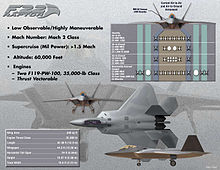The Lockheed Martin F-22 Raptor is an American single-seat, twin-engine, all-weather stealth tactical fighter aircraft developed for the United States Air Force (USAF). As the result of the USAF's Advanced Tactical Fighter (ATF) program, the aircraft was designed as an air superiority fighter, but also has ground attack, electronic warfare, and signals intelligence capabilities. The prime contractor, Lockheed Martin, built most of the F-22's airframe and weapons systems and conducted final assembly, while Boeing provided the wings, aft fuselage, avionics integration, and training systems.
The aircraft first flew in 1997 and was variously designated F-22 and F/A-22 before it formally entered service in December 2005 as the F-22A. Despite its protracted development and operational difficulties, USAF considers the F-22 a critical component of its tactical airpower. The fighter's combination of stealth, aerodynamic performance, and mission systems enable unprecedented air combat capabilities.
The USAF had originally planned to buy a total of 750 ATFs. In 2009, the program was cut to 187 operational aircraft due to high costs, a lack of air-to-air missions due to the focus on counterinsurgency operations at the time of production, a ban on exports, and the development of the more affordable and versatile F-35, with the last F-22 delivered in 2012.
.jpg) |
| An F-22 Raptor flies over Kadena Air Base, Japan, on a routine training mission in 2009. |
Role Air superiority fighter National origin United States Manufacturer
- Lockheed Martin Aeronautics
- Boeing Defense, Space & Security
First flight 7 September 1997 Introduction 15 December 2005 Status In service Primary user United States Air Force Produced 1996–2011 Number built 195 (8 test and 187 operational aircraft) Developed from Lockheed YF-22 Developed into
- Lockheed Martin X-44 MANTA
- Lockheed Martin FB-22
Specifications (F-22A)
General characteristics
- Crew: 1
- Length: 62 ft 1 in (18.92 m)
- Wingspan: 44 ft 6 in (13.56 m)
- Height: 16 ft 8 in (5.08 m)
- Wing area: 840 sq ft (78.04 m2)
- Aspect ratio: 2.36
- Airfoil: NACA 6 series airfoil
- Empty weight: 43,340 lb (19,700 kg)
- Gross weight: 64,840 lb (29,410 kg)
- Max takeoff weight: 83,500 lb (38,000 kg)
- Fuel capacity: 18,000 lb (8,200 kg) internally, or 26,000 lb (12,000 kg) with two 2× 600 US gal tanks
- Powerplant: 2 × Pratt & Whitney F119-PW-100 augmented turbofans, 26,000 lbf (116 kN) thrust each dry, 35,000 lbf (156 kN) with afterburner
Performance
- Maximum speed: Mach 2.25 (1,500 mph, 2,414 km/h) at altitude
- Mach 1.21, 800 knots (921 mph; 1,482 km/h) at sea level
- Mach 1.82 (1,220 mph, 1,963 km/h) supercruise at altitude
- Range: 1,600 mi (1,800 mi, 3,000 km) or more with 2 external fuel tanks
- Combat range: 460 mi (530 mi, 850 km) clean with 100 nmi (115 mi, 185 km) in supercruise
- 590 nmi (679 mi, 1,093 km) clean subsonic
- Ferry range: 1,740 nmi (2,000 mi, 3,220 km)
- Service ceiling: 65,000 ft (20,000 m)
- g limits: +9.0/−3.0
- Wing loading: 77.2 lb/sq ft (377 kg/m2)
- Thrust/weight: 1.08 (1.25 with loaded weight and 50% internal fuel)
Armament
- Guns: 1× 20 mm M61A2 Vulcan rotary cannon, 480 rounds
- Internal weapons bays:
- Air-to-air mission loadout:
- 6× AIM-120 AMRAM
- 2× AIM-9 Sidewinder
- Air-to-ground mission loadout:
- 2× 1,000 lb (450 kg) JDAM or 8× 250 lb (110 kg) GBU-39 Small Diameter Bombs
- 2× AIM-120 AMRAM
- 2× AIM-9 Sidewinder
- Air-to-air mission loadout:
- Hardpoint (external):
- 4× under-wing pylon stations can be fitted to carry weapons, each with a capacity of 5,000 lb (2,270 kg) or 600 U.S. gallon (2,270 L) drop tanks
- 4x AIM-120 AMRAAM (external)
Avionics
- AN/APG-77 or AN/APG-77(V)1 radar: 125–150 miles (201–241 km) against 1 m2 (11 sq ft) targets (estimated range), more than 250 miles (400 km) in narrow beams
- AN/AAR-56 Missile Launch Detector (MLD)
- AN/ALR-94 radar warning receiver (RWR): 250 nautical miles (460 km) or more detection range
- Integrated CNI Avionics
- MJU-39/40 flares for protection against IR missiles












0 Comments